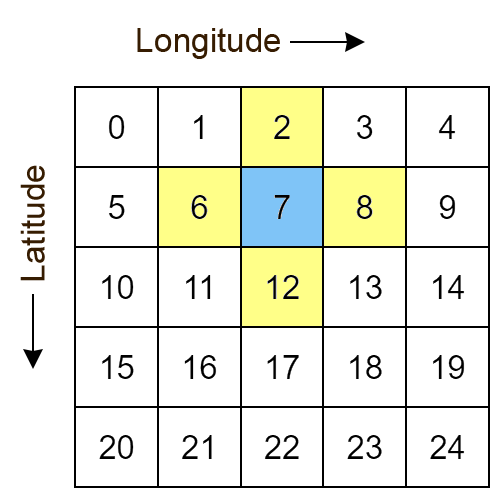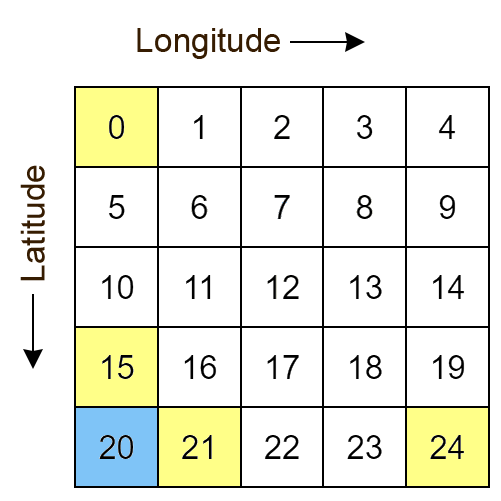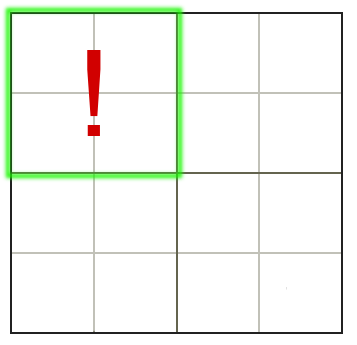Other examples
Caution
Before having a look at these examples, it’s highly recommended that you go through the Writing your First Program section!
Houses on a lattice
The model discussed earlier has no sense of geography: each house and office is practically isolated from all the others, as you can only infect people in your location. A simple way to try to introduce this into the model is by using houses on a grid, with the following characteristics:
Houses are arranged periodically in rows and columns
Each house has 4 nearest neighbours - namely the houses north, south, east, and west of them
Assume that people in a house can only infect their nearest neighbours
The inhabitants of a house are less likely to infect their neighbours than they are to their housemates

The lattice of houses - each square represents a house. Here, houses 2,6,8 and 12 are neighbours of 7, and could potentially infect or get infected by it.
To simplify what happens at the boundaries, we implement periodic boundary conditions. This means the left edge and the right edge are identified, and likewise for the top and bottom edges of the lattice. Apart from being easy to implement, a system with periodic bondary conditions can be thought of as one which feels the influence of it’s environment, rather than being isolated.

With periodic boundary conditions, house 24 is now to the left of 20, and 0 is below 20.
We use a 50 × 50 lattice, which totals to 2500 houses. We can also add an intervention to the model, to make it more realistic. We divide the lattice into larger ‘blocks’ of 100 houses each, so that a 5 × 5 arrangement of 25 blocks gives us our original lattice.
Note
The implementation below uses a block attribute in the house class. The blocks are numbered in the same way the houses are.
We can keep track of the number of infected in each block, and block it off if the infected count rises too high.

If we split a 4 × 4 lattice into 4 blocks, we can see the boundary cordoned off if block 1 has a large number of infected.
We shall cordon off a block in the following way:
If
infectedCountToTriggerBlockadeis above a threshold (we use 30), then the block needs to be closed offThe block is closed off for
blockadeDurationfrom the instant where the threshold is breached, regardless of the current levels of infectedAfter the block comes out of the blockade, it cannot get locked down again for
blockadeCooldowndays, regardless of the current levels of infected
Rather than having the initial infected people spread around, we’ll set them to be clustered in an area to better see the spread. We’ll set the four corners as the infected area: despite looking like 4 separate regions they’re actually all connected due to the periodic boundary conditions.
The model is built over an SIR model, with most of the changes being made to three classes: Main, SusceptibleState and GISOutputSpec.
There are several changes made to this class, the most important one being the addition of the intervention.
We first initialize isBlockadedList, a boolean array of length 25. If isBlockadedList[i] == True, that means that block number i is currently blockaded.
We use an IntervalBasedIntervention to set up our required intervention, and check for whether a block needs to be cordoned off every tick with whenActiveActionFunc.
Note
We start the intervention at tick 1, and end it at tick 5000. The simulation is assumed to have ended by then, as after numerous trials it never seemed to reach 5000 ticks. However, this is not good practice: we ideally should force the simulation to end when the intervention does, by adding the required condition in StopSimulation.
When ingesting the input data, we define a NEIGHBOURS relation between two neighbouring houses. However, we cannot register a relation between two nodes if only one of them has been registered. Thus, for every row in the input csv file, we register not just the house mentioned on the row but also all of it’s neighbours.
Hint
If you refer back to the final note in the section on Reading inputs from a synthetic population, you’ll see that registering an identical node multiple times does not lead to the node being duplicated in the graph.
What does what?
Here’s a breakdown of the primary methods in the Main class, and what they do.
blockadeBlock: Defines and registers the intervention described abovecreate12HourSchedules: Defines and registers the agent registerSchedulescsvDataExtractor: Creates the graph using the CSV input filegetLeftNeighbour,getRightNeighbour,getUpNeighbour,getDownNeighbour: Take a houses’ ID and returns the ID of the appropriate neighbour, after taking periodic boundary conditions into accountgetHouseBlock: Returns the block number a given house is part of
When it comes infection, the possibility of infecting others in neighbouring houses is taken care of in the fetchInfectedRatioForAllNeighbours method of this class. It does the following:
First, it calculates the number of infected and total people in the house itself.
Then it loooks at every neighbour of the house.
If the neighbour belongs to the same block, it adds that neighbour’s infected and total person counts.
If the neighbour doesn’t belong to the block, it checks if the neighbours’ block has been blockaded. If not, it adds the neighbour’s infected and total person counts.
Finally, it returns the ratio of the infected to total person count, which is used to check if the person gets infected.
This class generates the csv output.
It returns the following as a row:
The time-step
The coordinates of the house, if the house contains at least 1 infected person
The number of infected people in a house
A list of the blocks that have been cordoned off
Note
If a house doesn’t contain infected people, the house’s coordinates are not returned. This is intenional, as it reduces the size of the resulting csv file.
For this reason, an empty house with no people in it will never be listed in the output file: if there aren’t any people, they can’t be any infected people in the house.
The source code for these classes can be found below:
package com.bharatsim.examples.epidemiology.latticeHousesModel
import com.bharatsim.engine.ContextBuilder._
import com.bharatsim.engine._
import com.bharatsim.engine.actions.StopSimulation
import com.bharatsim.engine.basicConversions.decoders.DefaultDecoders._
import com.bharatsim.engine.basicConversions.encoders.DefaultEncoders._
import com.bharatsim.engine.dsl.SyntaxHelpers._
import com.bharatsim.engine.execution.Simulation
import com.bharatsim.engine.graph.ingestion.{GraphData, Relation}
import com.bharatsim.engine.graph.patternMatcher.MatchCondition._
import com.bharatsim.engine.intervention.{IntervalBasedIntervention, SingleInvocationIntervention}
import com.bharatsim.engine.listeners.{CsvOutputGenerator, SimulationListenerRegistry}
import com.bharatsim.engine.models.{Agent, Node}
import com.bharatsim.examples.epidemiology.latticeHousesModel.DiseaseStates.{InfectedState, SusceptibleState}
import com.bharatsim.examples.epidemiology.latticeHousesModel.InfectionStatus._
import com.typesafe.scalalogging.LazyLogging
import java.util.Date
object Main extends LazyLogging {
final val numberOfTicksInADay: Int = 2
final val dt: Double = 1/numberOfTicksInADay.toFloat
private val myTick: ScheduleUnit = new ScheduleUnit(1)
private val myDay: ScheduleUnit = new ScheduleUnit(myTick * numberOfTicksInADay)
var isBlockadedList = new Array[Boolean](25)
def main(args: Array[String]): Unit = {
var beforeCount = 0
val simulation = Simulation()
simulation.ingestData(implicit context => {
ingestCSVData("citizen10kLattice.csv", csvDataExtractor)
logger.debug("Ingestion done")
})
simulation.defineSimulation(implicit context => {
create12HourSchedules()
blockadeBlock
registerAction(
StopSimulation,
(c: Context) => {
getInfectedCount(c) == 0
}
)
beforeCount = getInfectedCount(context)
registerAgent[Person]
val currentTime = new Date().getTime
SimulationListenerRegistry.register(
new CsvOutputGenerator("src/main/resources/GISInfectedoutput_"+currentTime+".csv", new GISOutputSpec(context))
)
})
simulation.onCompleteSimulation { implicit context =>
printStats(beforeCount)
teardown()
}
val startTime = System.currentTimeMillis()
simulation.run()
val endTime = System.currentTimeMillis()
logger.info("Total time: {} s", (endTime - startTime) / 1000)
}
private def blockadeBlock(implicit context: Context): Unit = {
val interventionName = "blockade"
val infectedCountToTriggerBlockade = 30
val blockadeDuration = 7 * numberOfTicksInADay
val blockadeCooldown = 7 * numberOfTicksInADay
var ticksSinceBlockade = Array.fill(25){0}
def perTickAction(context: Context): Unit = {
for (i <- 0 to 24) {
if (ticksSinceBlockade(i) == blockadeDuration) {
isBlockadedList(i) = false
}
if (ticksSinceBlockade(i) >= blockadeDuration + blockadeCooldown) {
var infectedCountPerBlock: Long = 0
var nodesInBlock = context.graphProvider.fetchNodes("House", "block" equ i)
nodesInBlock.foreach(blockNode => {
var tempvariable = fetchInfectedAndTotalPerLocation(blockNode.as[House], "House", context)
infectedCountPerBlock += tempvariable._1.toLong
}
)
if (infectedCountPerBlock >= infectedCountToTriggerBlockade) {
isBlockadedList(i) = true
ticksSinceBlockade(i) = 0
}
}
else ticksSinceBlockade(i) += 1
}
}
def fetchInfectedAndTotalPerLocation(node: Node, placeType: String, context: Context): (Double, Double) = {
val cache = context.perTickCache
val uniquekey = (placeType, node.internalId)
cache.getOrUpdate(uniquekey, () => computeInfectedAndTotalPerLocation(node)).asInstanceOf[(Double, Double)]
}
def computeInfectedAndTotalPerLocation(node: Node): (Double, Double) = {
val totalNeighbourCount = node.getConnectionCount(node.getRelation[Person]().get)
if (totalNeighbourCount == 0)
return (0d, 1) // toDo change to (0,0), add check for dividing by 0
val infectedNeighbourCount = node.getConnectionCount(node.getRelation[Person]().get,
"infectionState" equ Infected)
return (infectedNeighbourCount.toDouble, totalNeighbourCount.toDouble)
}
val intervention =
IntervalBasedIntervention(interventionName, 1, 5000, whenActiveActionFunc = perTickAction)
registerIntervention(intervention)
}
private def create12HourSchedules()(implicit context: Context): Unit = {
val stayHomeSchedule = (myDay, myTick)
.add[House](0, 1)
registerSchedules(
(stayHomeSchedule, (agent: Agent, _:Context) => agent.asInstanceOf[Person].age > 0, 1)
)
}
private def csvDataExtractor(map: Map[String, String])(implicit context: Context): GraphData = {
val citizenId = map("Agent_ID").toLong
val age = map("Age").toInt
val homeId = map("HHID").toLong
val schoolId = map("school_id").toLong
val officeId = map("WorkPlaceID").toLong
val houseLatitude = map("H_Lat").toString
val houseLongitude = map("H_Lon").toString
val initialInfectionState = if ((houseLatitude=="0" || houseLatitude=="1" || houseLatitude=="49" ||
houseLatitude=="2" || houseLatitude=="48") && (houseLongitude=="0" || houseLongitude=="1" || houseLongitude=="49" ||
houseLongitude=="2" || houseLongitude=="48")) "Infected" else "Susceptible"
val citizen: Person = Person(
citizenId,
age,
houseLatitude,
houseLongitude,
InfectionStatus.withName(initialInfectionState),
0,
getInitialRecoveryTick(initialInfectionState)
)
if (initialInfectionState == "Susceptible") {
citizen.setInitialState(SusceptibleState())
}
else
citizen.setInitialState(InfectedState())
val home = House(homeId, getHouseBlock(homeId))
val staysAt = Relation[Person, House](citizenId, "STAYS_AT", homeId)
val memberOf = Relation[House, Person](homeId, "HOUSES", citizenId)
val neighboursLeft = Relation[House, House](homeId, "NEIGHBOURS", getLeftNeighbour(homeId))
val neighboursRight = Relation[House, House](homeId, "NEIGHBOURS", getRightNeighbour(homeId))
val neighboursUp = Relation[House, House](homeId, "NEIGHBOURS", getUpNeighbour(homeId))
val neighboursDown = Relation[House, House](homeId, "NEIGHBOURS", getDownNeighbour(homeId))
val graphData = GraphData()
graphData.addNode(citizenId, citizen)
graphData.addNode(homeId, home)
graphData.addRelations(staysAt, memberOf)
var lHomeId = getLeftNeighbour(homeId)
var rHomeId = getRightNeighbour(homeId)
var uHomeId = getUpNeighbour(homeId)
var dHomeId = getDownNeighbour(homeId)
graphData.addNode(lHomeId, House(lHomeId, getHouseBlock(lHomeId)))
graphData.addNode(rHomeId, House(rHomeId, getHouseBlock(rHomeId)))
graphData.addNode(uHomeId, House(uHomeId, getHouseBlock(uHomeId)))
graphData.addNode(dHomeId, House(dHomeId, getHouseBlock(dHomeId)))
graphData.addRelations(staysAt, memberOf)
graphData.addRelations(neighboursLeft, neighboursRight, neighboursUp, neighboursDown)
if (age >= 25) {
val office = Office(officeId)
val worksAt = Relation[Person, Office](citizenId, "WORKS_AT", officeId)
val employerOf = Relation[Office, Person](officeId, "EMPLOYER_OF", citizenId)
graphData.addNode(officeId, office)
graphData.addRelations(worksAt, employerOf)
} else {
val school = School(schoolId)
val studiesAt = Relation[Person, School](citizenId, "STUDIES_AT", schoolId)
val studentOf = Relation[School, Person](schoolId, "STUDENT_OF", citizenId)
graphData.addNode(schoolId, school)
graphData.addRelations(studiesAt, studentOf)
}
graphData
}
private def getLeftNeighbour(houseID: Long) : Long = {
if ((houseID + 1) % 50 == 0 ) {
houseID + 1 - 50
}
else houseID + 1
}
private def getRightNeighbour(houseID: Long) : Long = {
if (houseID % 50 == 0 ) {
houseID - 1 + 50
}
else houseID - 1
}
private def getUpNeighbour(houseID: Long) : Long = {
(houseID + 50) % 2500
}
private def getDownNeighbour(houseID: Long) : Long = {
(houseID - 50 + 2500) % 2500
}
def getHouseBlock(houseID: Long) : Int = {
val block_Lat = (houseID % 50) / 10
val block_Lon = (houseID / 50) / 10
5*block_Lat.toInt + block_Lon.toInt
}
private def printStats(beforeCount: Int)(implicit context: Context): Unit = {
val afterCountSusceptible = getSusceptibleCount(context)
val afterCountInfected = getInfectedCount(context)
val afterCountRecovered = getRemovedCount(context)
logger.info("Infected before: {}", beforeCount)
logger.info("Infected after: {}", afterCountInfected)
logger.info("Susceptible: {}", afterCountSusceptible)
logger.info("Recovered: {}", afterCountRecovered)
}
private def getInitialRecoveryTick(state: String): Double = {
if (state == "Susceptible") {
0
}
else {
numberOfTicksInADay*Disease.infectionDurationPDF.sample()
}
}
private def getSusceptibleCount(context: Context) = {
context.graphProvider.fetchCount("Person", "infectionState" equ Susceptible)
}
private def getInfectedCount(context: Context) = {
context.graphProvider.fetchCount("Person", "infectionState" equ Infected)
}
private def getRemovedCount(context: Context) = {
context.graphProvider.fetchCount("Person", "infectionState" equ Removed)
}
}
package com.bharatsim.examples.epidemiology.latticeHousesModel.DiseaseStates
import com.bharatsim.engine.Context
import com.bharatsim.engine.basicConversions.decoders.DefaultDecoders._
import com.bharatsim.engine.basicConversions.encoders.DefaultEncoders._
import com.bharatsim.engine.fsm.State
import com.bharatsim.engine.graph.GraphNode
import com.bharatsim.engine.graph.patternMatcher.MatchCondition._
import com.bharatsim.engine.models.{Network, Node, StatefulAgent}
import com.bharatsim.engine.utils.Probability.biasedCoinToss
import com.bharatsim.examples.epidemiology.latticeHousesModel.InfectionStatus._
import com.bharatsim.examples.epidemiology.latticeHousesModel.Main.{isBlockadedList, dt, numberOfTicksInADay}
import com.bharatsim.examples.epidemiology.latticeHousesModel.{Disease, House, Office, Person, School}
import com.bharatsim.examples.epidemiology.latticeHousesModel.DiseaseStates.InfectedState
case class SusceptibleState() extends State {
override def enterAction(context: Context, agent: StatefulAgent): Unit = {
agent.updateParam("infectionState", Susceptible)
}
def shouldBeInfected(context: Context, agent: StatefulAgent): Boolean = {
val exposureProbability = Disease.lambda_s * dt
val schedule = context.fetchScheduleFor(agent).get
val currentStep = context.getCurrentStep
val placeType: String = schedule.getForStep(currentStep)
val places = agent.getConnections(agent.getRelation(placeType).get).toList
if (places.nonEmpty) {
val place = places.head
val decodedPlace = decodeNode(placeType, place)
val infectedNeighbourFraction = fetchInfectedRatioForAllNeighbours(decodedPlace, placeType, context)
if (biasedCoinToss(exposureProbability * infectedNeighbourFraction)) {
agent.updateParam("RecoveryTick", context.getCurrentStep.toDouble + numberOfTicksInADay * Disease.infectionDurationPDF.sample())
true
}
else false
}
else false
}
def fetchInfectedRatioForAllNeighbours(node:Node, placeType: String, context: Context): Double = {
val neighbourList = node.getConnections("NEIGHBOURS")
var temp_return = fetchInfectedAndTotalPerLocation(node, placeType, context)
var neighbouringInfectedNumber = temp_return._1
var neighbouringTotalNumber = temp_return._2
if (neighbourList.nonEmpty) {
neighbourList.foreach(neighbouringNode => {
if (node.asInstanceOf[House].block == neighbouringNode.as[House].block) {
var temp_return2 = fetchInfectedAndTotalPerLocation(neighbouringNode.as[House], placeType, context)
neighbouringInfectedNumber += temp_return2._1
neighbouringTotalNumber += temp_return2._2
}
else if (! isBlockadedList(neighbouringNode.as[House].block)) {
var temp_return2 = fetchInfectedAndTotalPerLocation(neighbouringNode.as[House], placeType, context)
neighbouringInfectedNumber += temp_return2._1
neighbouringTotalNumber += temp_return2._2
}
})
}
neighbouringInfectedNumber.toDouble / neighbouringTotalNumber.toDouble
}
def fetchInfectedAndTotalPerLocation(node: Node, placeType: String, context: Context): (Double, Double) = {
val cache = context.perTickCache
val uniquekey = (placeType, node.internalId)
cache.getOrUpdate(uniquekey, () => computeInfectedAndTotalPerLocation(node)).asInstanceOf[(Double, Double)]
}
def computeInfectedAndTotalPerLocation(node: Node): (Double, Double) = {
val totalNeighbourCount = node.getConnectionCount(node.getRelation[Person]().get)
if (totalNeighbourCount == 0)
return (0d, 1) // toDo change to (0,0), add check for dividing by 0
val infectedNeighbourCount = node.getConnectionCount(node.getRelation[Person]().get,
"infectionState" equ Infected)
return (infectedNeighbourCount.toDouble, totalNeighbourCount.toDouble)
}
def decodeNode(classType: String, node: GraphNode): Node = {
classType match {
case "House" => node.as[House]
case "Office" => node.as[Office]
case "School" => node.as[School]
}
}
addTransition(
when = shouldBeInfected,
to = context => InfectedState()
)
}
package com.bharatsim.examples.epidemiology.latticeHousesModel
import com.bharatsim.engine.Context
import com.bharatsim.engine.basicConversions.decoders.DefaultDecoders._
import com.bharatsim.engine.graph.patternMatcher.MatchCondition._
import com.bharatsim.engine.listeners.CSVSpecs
import com.bharatsim.examples.epidemiology.latticeHousesModel.InfectionStatus._
import com.bharatsim.examples.epidemiology.latticeHousesModel.Main.isBlockadedList
import scala.collection.mutable
import scala.collection.mutable.ListBuffer
class GISOutputSpec(context: Context) extends CSVSpecs {
override def getHeaders: List[String] = List("Step", "latitude", "longitude", "infectedCount", "blockadedBlocks")
private def roundLatLong(lat: String, long: String): (Double, Double) = {
val scale = 1
(
BigDecimal(lat).setScale(scale, BigDecimal.RoundingMode.DOWN).toDouble,
BigDecimal(long).setScale(scale, BigDecimal.RoundingMode.DOWN).toDouble
)
}
override def getRows(): List[List[Any]] = {
if (context.getCurrentStep % 2 == 0) {
val label = "Person"
val countByLatLong = new mutable.HashMap[(Double, Double), Int]()
val people = context.graphProvider.fetchNodes(
label,
("infectionState" equ Infected)
)
people.foreach((p) => {
val person = p.as[Person]
val latLong = roundLatLong(person.lat, person.long)
val infectedCount = countByLatLong.getOrElseUpdate(latLong, 0)
countByLatLong.put(latLong, infectedCount + 1)
})
val blockadedBlocks = isBlockadedList.zipWithIndex.filter(pair => pair._1).map(pair => pair._2)
// divides the list into pairs with (truthvalue, index).Then checks if pair._1 is true, if so it returns the index
val rows = ListBuffer.empty[List[String]]
countByLatLong.toList.foreach((kv) => {
val latLong = kv._1
val count = kv._2
rows.addOne(List(context.getCurrentStep.toString, latLong._1.toString, latLong._2.toString, count.toString,
blockadedBlocks.mkString("(", ", ", ")")))
})
return rows.toList
} else {
List.empty
}
}
}